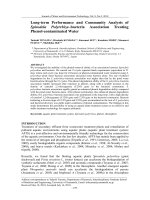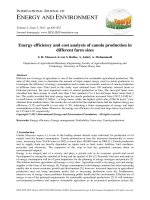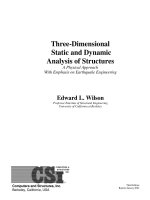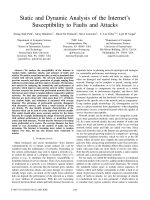- Trang chủ >>
- Khoa Học Tự Nhiên >>
- Vật lý
Energy and exergy analysis of particle dispersed latent heat storage system
Bạn đang xem bản rút gọn của tài liệu. Xem và tải ngay bản đầy đủ của tài liệu tại đây (547.64 KB, 14 trang )
I
NTERNATIONAL
J
OURNAL OF
E
NERGY AND
E
NVIRONMENT
Volume 1, Issue 3, 2010 pp.445-458
Journal homepage: www.IJEE.IEEFoundation.org
ISSN 2076-2895 (Print), ISSN 2076-2909 (Online) ©2010 International Energy & Environment Foundation. All rights reserved.
Energy and exergy analysis of particle dispersed latent heat
storage system
S. Jegadheeswaran, S. D. Pohekar
Mechanical Engineering, Tolani Maritime Institute, Induri, Pune 410 507, India.
Abstract
Latent heat thermal storage (LHTS) system has been attractive over the years as an effective energy
storage and retrieval device especially in solar thermal applications. However, the performance of LHTS
systems is limited by the poor thermal conductivity of phase change materials (PCMs) employed. A
numerical study is carried out to investigate the performance enhancement of a LHTS unit of shell and
tube configuration due to the dispersion of high conductivity particles in the PCM during charging
process (melting). Temperature based governing equations have been formulated and solved numerically
following an alternate iteration between the temperature and thermal resistance. Exergy based
performance evaluation is taken as a main aspect. The numerical results are presented for several mass
flow rates and inlet temperatures of heat transfer fluid (HTF). The results indicate a significant
improvement in the performance of the LHTS unit when high conductivity particles are dispersed.
Copyright © 2010 International Energy and Environment Foundation - All rights reserved.
Keywords: Latent heat storage system, Phase change material, Melting, Exergy, Thermal resistance.
1. Introduction
The large scale utilization of the many sources of thermal energy like solar thermal energy, hot waste
streams available in industries etc., may be handicapped, if not properly managed. The major problem in
managing energy from the above-mentioned sources is the time gap between availability and need. The
storage of thermal energy has been emphasized as an attractive solution for such kind of problems on
energy management and conservation, in both industrial and domestic sectors. For the last three decades,
there has been a growing interest in latent heat thermal storage (LHTS) technique, which has been
proved as a better engineering option over sensible heat storage. They offer several advantages such as
high energy storage, uniform temperature of operation, simple configuration, etc. In spite of the relative
merits, the phase change material (PCM) loaded in the LHTS unit possesses a very low thermal
conductivity, which drastically affects the performance of the unit. The various performance techniques
proposed and studied are employing fins [1-3], multiple PCMs [4, 5] and increasing the thermal
conductivity of conventional PCMs with the help of additives [6-8]. For the recent review on the various
performance enhancement techniques employed for LHTS units, readers are referred to the paper by
Jegadheeswaran and Pohekar [9]. However, only a limited number of works is reported on dispersion of
high conductivity particles, although a large number of studies have focused on other performance
enhancement techniques. Seeniraj et al. [6] investigated the effect of high conductivity particles
dispersed in the PCM on the performance during the melting process. It is reported that though the
446
International Journal of Energy and Environment (IJEE), Volume 1, Issue 3, 2010, pp.445-458
ISSN 2076-2895 (Print), ISSN 2076-2909 (Online) ©2010 International Energy & Environment Foundation. All rights reserved.
dispersion enhances the performance considerably, there exists an optimum fraction for the particles
beyond which, the energy storage capacity would reduce. Khodadadi and Hosseinizadeh [7] have
reported that nano copper particles could enhance the heat release rate of PCM (water) significantly
during the solidification. Mettawee and Assassa [8] carried out experimental study to investigate the
influence of aluminium particles on melting and solidification processes of paraffin used in solar
collector. The results revealed that the time required for charging and discharging processes could be
reduced substantially by adding the aluminium particles. Hence, the mean daily efficiency of the solar
collector with composite PCM was much higher than that of with pure paraffin. The studies on LHTS
units employing performance enhancement techniques have mainly focused on evaluation of
melting/solidification time, heat transfer rate and amount of energy stored/retrieved in comparison with
those of system without enhancement techniques. Recently, Verma et al. [10] have pointed out that
thermal analysis of LHTS systems based on only first law of thermodynamics (energy analysis) may not
produce a system with highest possible thermodynamic efficiency although workable designs may be
possible. This indicates that energy analysis becomes inadequate as information on quality of energy
stored/recovered cannot be obtained. In other words, energy analysis does not reflect the usefulness of
energy. Hence, an ‘optimized LHTS unit’ based on first law is not necessarily an optimum system. This
inadequacy can be overcome, if an analysis based on second law of thermodynamics (exergy) is carried
out for LHTS units.
Exergy based performance evaluation of LHTS units has been reported by few
researchers [11-14]. To the best of the authors’ knowledge, however, exergy analysis is carried out only
for multiple PCMs technique [15, 16] and no exergy work is reported for high conductivity particles.
In this work, an attempt is made to study the effect of the dispersion of high conductivity particles on the
melting rate and energy /exergy storage in a LHTS unit through mathematical modelling. The
comparison between the performance of particle dispersed unit and that of conventional pure PCM
charged unit is presented for different mass flow rates and inlet temperatures of HTF.
2. Physical model
The LHTS system consists of a bank of tubes arranged in a particular pattern inside an insulated shell.
The shell side is loaded with either pure PCM or PCM dispersed with high conductivity particles and the
tube side carries the HTF that flows at a constant inlet temperature higher than the fusion temperature of
the PCM. This initiates the melting process. As symmetry is assumed to prevail around a single tube with
PCM-particle mix surrounding it, the present analysis has been restricted to the region shown in Figure 1
with the symmetry line taken to be adiabatic. The entire PCM is assumed to be at its fusion temperature
(solid phase) initially. The selected materials for PCM and high conductivity particles are technical grade
paraffin and copper. The thermophysical properties of PCM [17] and copper [7] are given in Table 1.
Water is used as HTF as the system corresponds to that one used for solar water heaters.
Table 1. Thermophysical properties of technical grade paraffin and copper
Properties Paraffin Copper
Fusion temperature (K) 300.7 -
Latent heat of fusion (kJ/kg) 206 -
Thermal conductivity (W/m.K) 0.18(solid)/0.19(liquid) 400
Specific heat (kJ/kg.K) 1.8 (solid)/2.4(liquid) 0.383
Density (kg/m
3
) 789(solid)/750(liquid) 8954
3. Mathematical modelling
The performance evaluation of LHTS systems requires thorough knowledge of the transient thermal
characteristics during the phase change process. Phase change problems are examples of what are closely
referred to as moving boundary problems and their study presents one of the most exciting and
challenging areas of current applied mathematical research. The existence of a moving boundary
generally means that the problem does not admit a simple closed form analytical solution and
accordingly much research has focused on approximate solution techniques. In general, phase change
problems involve a transient, non-linear phenomenon with a moving liquid-solid interface whose
position is unknown a priori and also flow problems associated with HTF. In addition, the two phases of
PCM may have different properties and configuration of the LHTS unit may differ with the applications.
Substantial number of numerical based studies on LHTS units employing enhancement techniques and
447
International Journal of Energy and Environment (IJEE), Volume 1, Issue 3, 2010, pp.445-458
ISSN 2076-2895 (Print), ISSN 2076-2909 (Online) ©2010 International Energy & Environment Foundation. All rights reserved.
on their performance measurement is available in literature. The numerical formulation widely
implemented so far is enthalpy method. However, in the present study a relatively simpler method called
alternate temperature and thermal resistance method proposed by Yingqiu et al. [18] has been employed.
The details of the mathematical approach are discussed in this section.
3.1 Assumptions
The following assumptions / statements are made to enable the mathematical modelling of the LHTS
unit:
• Physical properties of the PCM in both liquid and solid phase are constant and however, may be
different for different phases
• Natural convection in the liquid PCM is neglected i.e the heat transfer within PCM is purely by
conduction [5]
• As the length of the tube is large compared to its diameter, thermal entrance effects are neglected
in the HTF. The flow of HTF is turbulent and fully developed
• No settlement of particles on the tube surface due to density effects
• The particles are in local thermodynamic equilibrium with the surrounding PCM
Figure 1. Schematic of LHTS unit
3.2 Formulation
The following equations are arrived by establishing energy balances at the respective regions of HTF,
wall and PCM.
)],(),([2
),(
txTtxThr
x
txT
mc
wffi
f
ff
−=
∂
∂
π
(1)
where c
f
is the specific heat of HTF (J/kg.K), m
f
is the mass flow rate of HTF (kg/s), T
f
and T
w
are
temperatures (K) of HTF and wall respectively, r
i
is the tube inner radius (m), h
f
is the HTF side heat
transfer coefficient (W/m
2
.K), x is the axial distance (m), t is the time (s). Since the rate of energy
transfer through the tube wall to the PCM is equal to that from HTF to tube wall, we have,
),(),(
),(),(
txRRR
R
TtxT
txTtxT
mwf
f
mf
wf
++
=
−
−
(2)
448
International Journal of Energy and Environment (IJEE), Volume 1, Issue 3, 2010, pp.445-458
ISSN 2076-2895 (Print), ISSN 2076-2909 (Online) ©2010 International Energy & Environment Foundation. All rights reserved.
where T
m
is the fusion temperature of PCM (K), R
f,
R
w,
R
m
are the thermal resistances (K/W) in HTF, wall
and PCM respectively.
Rate of change of latent heat stored in a given time interval is equal to the heat convected during that
time interval, hence,
()
)],(),([2
),(
1
int
txTtxThr
t
txr
He
wffimm
−=
∂
∂
−
πρ
(3)
where e is the volume fraction of particles in the PCM, ρ
m
is the density of the PCM (kg/m
3
), H
m
is the
latent heat of fusion of PCM (J/kg), r
int
is the radial interface location (m).
The following initial and boundary conditions are specified in the analysis. Initial conditions:
inf
TtxT == )0,(
(4a)
where T
in
is the inlet temperature of HTF (K).
w
rtxr == )0,(
int
(4b)
where r
w
is the tube outer radius (m).
Boundary conditions:
inf
TtxT == ),0(
(4c)
To simplify the formulation, the following dimensionless variables are employed:
m
H
m
T
in
T
m
c
Ste
mix
kor
m
k
i
r
f
h
Bi
f
c
f
m
L
i
r
f
h
NTU
o
r
t
m
Fo
o
r
r
r
L
x
X
m
T
in
T
w
T
in
T
w
T
m
T
in
T
f
T
in
T
f
T
)(
;
)(
;
2
;
2
;
int
*
int
;;
*
;
*
−
====
==
−
−
=
−
−
=
π
α
(4d)
where T
*
f
and T
*
w
are the dimensionless temperatures of HTF and wall respectively,
X
is the
dimensionless axial coordinate,
L
is the length of the tube (m)
,
r
*
int
is the dimensionless radial interface
location,
Fo
is the Fourier number,
α
m
is the thermal diffusivity of PCM (m
2
/s),
NTU
is the number of
transfer units,
Bi
is the Biot number,
Ste
is the Stefan number,
c
m
is the specific heat of PCM (J/kg.K),
k
m
is the thermal conductivity of pure PCM (W/m.K),
k
mix
is the thermal conductivity of PCM-particle
mixture (W/m.K) which can be calculated as a function of particle volume fraction as,
()
()
⎥
⎥
⎦
⎤
⎢
⎢
⎣
⎡
−++
−−+
=
pmmp
pmmp
mmix
kkekk
kkekk
kk
2
22
(4e)
where
p
k
is the thermal conductivity of high particles dispersed (W/m.K).
Using the above dimensionless variables, equations (1)-(3) are written in dimensionless form as,
⎟
⎠
⎞
⎜
⎝
⎛
−
⎥
⎥
⎦
⎤
⎢
⎢
⎣
⎡
++
=
∂
∂
),(1
),(
)(
),(
*
*
FoX
txRRR
R
NTU
X
FoX
f
T
f
T
mwf
f
(5)
⎟
⎠
⎞
⎜
⎝
⎛
−
⎥
⎥
⎦
⎤
⎢
⎢
⎣
⎡
++
⎟
⎟
⎠
⎞
⎜
⎜
⎝
⎛
−
=
∂
∂
),(1
),()1(
2
),(
*
2*
int
FoX
txRRR
R
Ste
k
k
e
Bi
Fo
FoXr
f
T
mwf
f
m
mix
(6)
Equations (5) and (6) and subjected to the following dimensionless initial and boundary conditions,
Initial conditions:
449
International Journal of Energy and Environment (IJEE), Volume 1, Issue 3, 2010, pp.445-458
ISSN 2076-2895 (Print), ISSN 2076-2909 (Online) ©2010 International Energy & Environment Foundation. All rights reserved.
0)0,(
*
==FoX
f
T
for 0≤X≤1 (7a)
1)0,(
*
int
==FoX
r
for 0≤X≤1 (7b)
Boundary conditions:
0),0(
*
== FoX
f
T
for
Fo
>0 (7c)
3.3 Solution
The dimensionless expressions for the axial variation of HTF temperature and interface location at any
instant can be easily obtained by integrating equations (5) and (6) with respect to
X
and
Fo
respectively
and subsequent application of the initial and boundary conditions and are given as follows:
⎥
⎥
⎥
⎥
⎥
⎦
⎤
⎢
⎢
⎢
⎢
⎢
⎣
⎡
⎟
⎟
⎠
⎞
⎜
⎜
⎝
⎛
⎟
⎟
⎠
⎞
⎜
⎜
⎝
⎛
⎟
⎟
⎠
⎞
⎜
⎜
⎝
⎛
+
⎟
⎠
⎞
⎜
⎝
⎛
+
∆−−=
∑
=
j
in
i
w
w
m
m
mix
r
r
k
k
k
k
BiFoXBi
XNTUFoX
r
f
T
ln),(ln1
1
exp1),(
*
int
*
(8)
()
⎥
⎥
⎥
⎥
⎥
⎦
⎤
⎢
⎢
⎢
⎢
⎢
⎣
⎡
⎟
⎟
⎠
⎞
⎜
⎜
⎝
⎛
⎟
⎟
⎠
⎞
⎜
⎜
⎝
⎛
⎟
⎟
⎠
⎞
⎜
⎜
⎝
⎛
+
⎟
⎠
⎞
⎜
⎝
⎛
+
⎟
⎠
⎞
⎜
⎝
⎛
⎟
⎟
⎠
⎞
⎜
⎜
⎝
⎛
−
+=
∑
=
∆−
j
in
i
w
w
m
m
mix
m
mix
r
r
k
k
k
k
BiFoXBi
Ste
k
k
e
Bi
FoX
r
FoFoX
f
T
r
ln),(ln1
1
2
1),(
*
int
),(
*
1
*
int
(9)
The solution can be obtained by solving the above equations alternatively at each time step until a
desired convergence. For the numerical solution, a computational mesh was created with grid size (
X∆
)
of 0.1. The unsteady analysis was carried out with a time step size of 0.01 s. The grid size and time step
were selected after a careful grid and time step independence study. The converged results were assumed
to be reached when the relative change between the values of
T
*
f
(X, Fo)
and
r
*
int
(X, Fo)
in subsequent
iterations was less than 1x10
-5
. Initial condition for the iteration is as given in equation (7b).
4. Energy and exergy analysis
At any time, the cumulative energy stored in the PCM is given by,
()
()
mmw
HeLrrE
ρ
π
−−= 1
2
22
int
(10)
where
E
is the cumulative energy stored (J).
Subsequently, the cumulative exergy stored in the PCM at any time can be calculated as follows:
⎥
⎦
⎤
⎢
⎣
⎡
−
m
o
m
T
T
E=Ex 1
(11)
where
Ex
m
is the cumulative exergy stored in the PCM(J),
o
T
is the temperature of environment (K).
The exergy transferred by the HTF can be written as,
()
t
T
T
TTTcm=Ex
in
out
oinoutfff
∇
⎥
⎥
⎦
⎤
⎢
⎢
⎣
⎡
⎟
⎟
⎠
⎞
⎜
⎜
⎝
⎛
−− ln
(12)
where
Ex
f
is the exergy transferred by the HTF (J),
T
out
is the temperature of the HTF at the outlet (K).
The present system studied is assumed as an adiabatic and hence, the heat transferred by the HTF is
completely stored in the PCM. As a result, the efficiency of the system becomes unity all the time.
Hence, the calculation of energy efficiency does not indicate the true performance of the system. This
shortcoming can be overcome, if exergy efficiency is computed.









